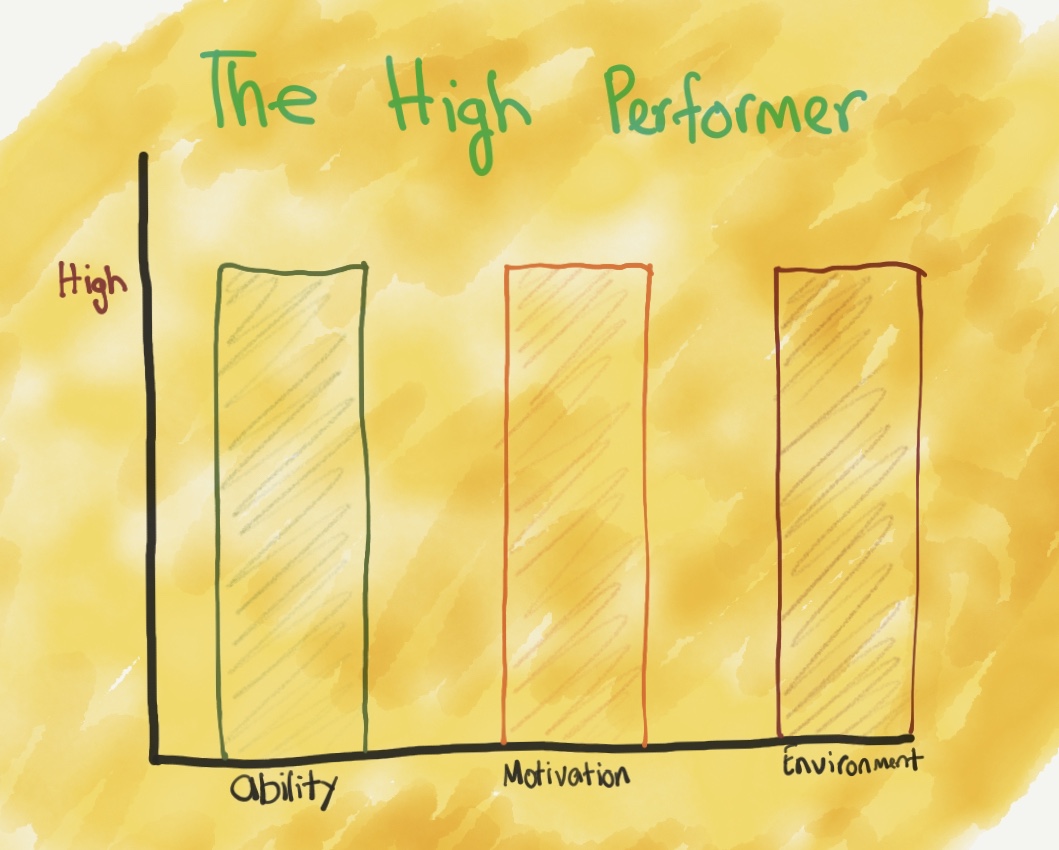Beginning with a story here. Back in 2008, I was a couple of years out of college and working for a software company in Dhaka, Bangladesh. Like many of my classmates from my college, I was studying GRE alongside my job for a PhD admission in a reputable US university. That process being long and uncertain, I also applied for an MBA program at the University of Dhaka as a backup plan. The GRE preparation came in very handy and I qualified for the evening MBA program. I started MBA classes in January 2009 before the universities in USA and Canada made their decision on my application. There, I took a course on Management. I was too naive and still too much an engineer to pay attention.
But this image that our teacher drew on the board got stuck in my head to this day.

Fast forward ten years and I still like how cleanly it captures the essence of high performance of an employee as a combination of the employee’s ability and motivation in a suitable environment.
Given this is how high-performers are, it’s possible to plot a similar graph for low performers as a diagnostic report. If such a diagnosis is right, it can provide a valuable strategy for managers and employees to work towards improving employee performance. For example, if an employee lacks skill and motivation but fits very well within the work environment, a manager can focus on skills training and suggesting therapies to increase motivation. Similarly, if an employee is unable to acquire the skills for a particular job, focusing on motivation or changing the environment for that employee may not fix the low performance issue.
Based on the past 14 years of my time in the industry, I’ve shared some symptoms of low performance that I’ve seen. You can use this as an exercise sheet to plot your diagnosis of the low performer’s chart.
New hire too slow to ramp up: You were impressed by a candidate during the interview. The same interview process was used to find many high performers in the past. But this employee is struggling to ramp up.
Knowledge vs. application: You have an employee who’s always studying job related skills and shows a great deal of interest in training, but can’t translate the knowledge into application.
Complains about the lack of time: You have an employee struggling to produce the best outcome. In your one:one meeting, the employee always complains about lack of time even after you give him/her the time.
Frequently runs into conflicts: Your dream employee is causing too many conflicts within the team.
Can’t write thoughts down: You have an employee who’s unhappy about things. When you want them to write it down, they are unable to produce a crisp writeup about the problems and potential solutions.
Doesn’t make hard decisions timely: You have a leader that stays away from making hard decisions. In their mind, they want someone else to make them take the hard decision.
Isn’t aware of better ways to solve old problems: You have an employee who’s expert in certain ways of delivering work but lacks awareness of newer and more efficient ways.
Doesn’t take initiative: You encourage and reward employees to take initiatives that help the business. Yet, you see an employee is not taking part.
The good news is, once a diagnosis is accurate for such symptoms of low performance, you can move ahead and implement a concrete improvement strategy for your employee. The clarity of this simple method helped me in many situations.
I hope this helps you, too.